Our beloved canine companions are part of the family, and it’s natural to want to share everything with them, including our food. However, many common household foods that are perfectly safe and even healthy for humans can be toxic or dangerous for dogs. Understanding what foods dogs cannot eat is crucial for their well-being, as pet poisonings are a significant threat. Each year, hundreds of thousands of pet poisonings occur, with common human foods being a major contributor.
Dogs have unique digestive systems and metabolic processes that differ greatly from ours, making some substances harmful to them even in small quantities. This guide from Dog Care Story aims to equip you with essential knowledge about foods to avoid, along with those that are safe, helping you keep your furry friend healthy and safe. By being informed, you can prevent accidental ingestions and ensure your dog receives only nutritious and appropriate treats.
Why Certain Foods Are Toxic to Dogs
The question of “what can dogs eat and not eat” often comes down to fundamental physiological differences. A dog’s digestive system and metabolism are distinct from a human’s, which is why foods that are harmless or beneficial for us can be quite detrimental, or even fatal, for dogs. Their bodies process certain substances in unique ways, often leading to a buildup of toxins.
For instance, the stimulant compounds theobromine and caffeine found in chocolate are metabolized much slower by dogs than by humans. This slow processing allows these substances to accumulate rapidly in their system, potentially reaching toxic levels that can be life-threatening. Similarly, while the fleshy parts of many fruits are safe, the pits, seeds, and stems can contain cyanide. Although a human might easily digest a cherry, the cyanide within its pit poses a risk if a dog consumes a large quantity. Furthermore, large fruit pits can cause gastrointestinal obstruction, leading to severe discomfort and possible blockage, which is why it’s best to avoid them altogether.
Food toxicity can also vary based on several factors unique to each dog, including their size, breed, age, and existing health conditions. A small breed dog, for example, may be more severely affected by a small amount of a toxic substance compared to a large breed. Puppies and elderly dogs often have more sensitive digestive systems or compromised health, increasing their vulnerability. This highlights the importance of consulting your veterinarian if you have any doubts or questions regarding what your dog can or cannot eat. Your vet can provide tailored advice based on your dog’s specific needs and health profile.
Comprehensive List of Common Foods Dogs Cannot Eat
Many everyday household foods, treats, and even spices can be dangerous, and often highly toxic, to dogs. While this list details some of the most common and critical foods that are bad for a dog to eat, it is not exhaustive. Always err on the side of caution if you are unsure about a particular food item.
1. Alcohol
Because dogs and cats are significantly smaller than humans, alcohol can have a much more pronounced and deadly effect on them. Even minimal amounts of alcohol can lead to severe harm, and the risk increases dramatically with smaller body weight. Symptoms of alcohol poisoning in dogs mirror those in humans, including vomiting, breathing difficulties, loss of coordination, coma, and even death.
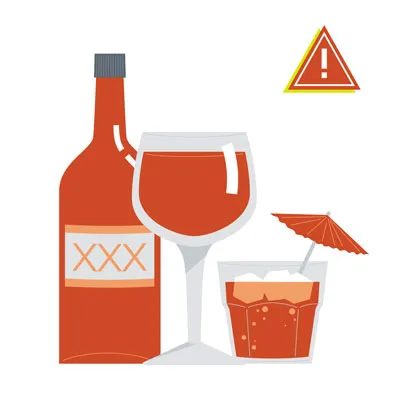 Dog sniffing a glass of alcohol, highlighting the dangers of alcohol for dogs
Dog sniffing a glass of alcohol, highlighting the dangers of alcohol for dogs
2. Apple, Apricot, Cherry, and Plum Seeds/Pits
While the crisp, fleshy part of an apple is generally safe for dogs, the core and seeds are not. Apple seeds contain cyanide, a potent toxin. Although a tiny amount might not cause immediate harm, it’s always safest to completely remove the core and seeds. Similarly, the seeds and pits from apricots, cherries, peaches, and plums also contain cyanide. Ingestion can lead to severe symptoms such as vomiting, an irregular and rapid heartbeat, seizures, coma, and ultimately, death, due to the impairment of red blood cells’ ability to carry oxygen. Furthermore, these hard pits can pose a choking hazard or cause a dangerous gastrointestinal obstruction.
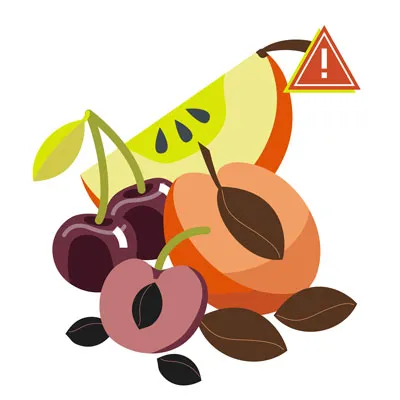 Various fruit pits including apple seeds, apricot, cherry, and plum pits, warning of cyanide toxicity for dogs
Various fruit pits including apple seeds, apricot, cherry, and plum pits, warning of cyanide toxicity for dogs
3. Avocado
Avocados are generally not a good choice for dogs. They contain a fungicidal toxin called persin, which can cause vomiting and diarrhea in dogs, and has been linked to more severe issues like myocardial damage in other animal species, although this specific reaction hasn’t been consistently replicated in dogs. Moreover, an intact avocado pit presents a significant choking hazard and can easily obstruct a dog’s gastrointestinal tract, necessitating emergency veterinary intervention. It’s simply best to keep this fruit away from your canine companion.
 Ripe avocado, illustrating that avocado is a bad food for dogs due to persin and choking hazard
Ripe avocado, illustrating that avocado is a bad food for dogs due to persin and choking hazard
4. Broccoli
Broccoli contains isothiocyanates, which can be harmful to pets in very large doses. While small amounts of broccoli might be acceptable occasionally for some dogs, it’s generally advisable to avoid it, especially considering the abundance of safer and healthier vegetable options available. Additionally, the fibrous stalks of broccoli can sometimes pose a choking risk or lead to an obstruction in a dog’s throat.
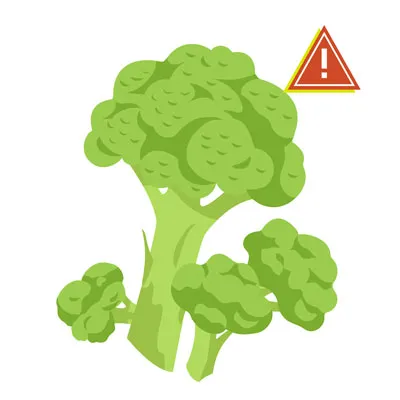 Fresh green broccoli florets, explaining why large amounts of broccoli can be harmful for dogs
Fresh green broccoli florets, explaining why large amounts of broccoli can be harmful for dogs
5. Caffeine and Coffee Grounds
Caffeine, found in coffee, tea, energy drinks, and chocolate, contains methylxanthines. These compounds can be highly toxic to dogs, potentially causing fatal symptoms such as severe diarrhea, vomiting, seizures, and irregular heart rhythms. Even accidentally ingesting coffee grounds or highly caffeinated beverages can cause a dog’s heart to race, leading to tremors, arrhythmia, difficulty breathing, and other serious symptoms. Always keep caffeinated products out of your dog’s reach.
 Coffee beans and ground coffee, symbolizing caffeine and coffee grounds which are toxic for dogs
Coffee beans and ground coffee, symbolizing caffeine and coffee grounds which are toxic for dogs
6. Chicken and Turkey Skin, Ham, and Other Fatty Cuts of Meat
Fatty meats and meat trimmings, such as chicken or turkey skin and ham, are extremely detrimental to dogs. Their high-fat content can trigger acute pancreatitis, a life-threatening inflammatory condition of the pancreas that can lead to severe complications. Rather than giving these scraps as treats, it is safer to dispose of them. Furthermore, avoid giving dogs cooked poultry bones. Cooked bones become brittle and can splinter easily, leading to internal injuries, such as obstructions or punctures in the digestive tract, which can cause fatal abdominal infections.
 Plate with fatty meat scraps like chicken skin and ham, harmful for dogs due to pancreatitis risk
Plate with fatty meat scraps like chicken skin and ham, harmful for dogs due to pancreatitis risk
7. Chocolate
Chocolate toxicity is one of the most widely recognized and common causes of pet poisoning, particularly during holidays. Dogs absolutely cannot eat any chocolate product. Chocolate contains a compound called theobromine, which is toxic to dogs, along with caffeine. The darker the chocolate (e.g., baker’s chocolate, dark chocolate), the higher its concentration of theobromine, making it more dangerous. Some sugar-free chocolates also contain xylitol, which is another severe toxin for dogs. Dogs and cats metabolize chocolate poorly compared to humans. Symptoms of chocolate ingestion can include hyperactivity, vomiting, diarrhea, pancreatitis, abnormal heart rhythm, and seizures. If your dog consumes any amount of chocolate, regardless of how small, contact your veterinarian immediately.
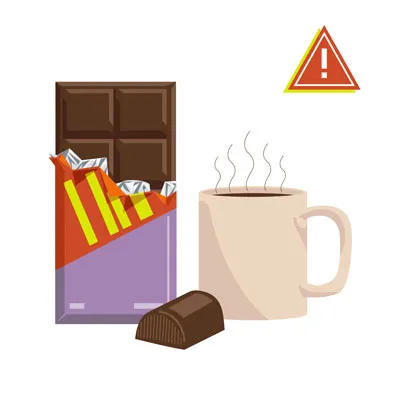 Various forms of chocolate, from dark to milk, representing a highly toxic food for dogs due to theobromine
Various forms of chocolate, from dark to milk, representing a highly toxic food for dogs due to theobromine
8. Grapes and Raisins
Grapes and raisins are exceptionally dangerous for dogs. These seemingly harmless fruits can cause acute kidney failure, even in small quantities. The exact toxic component is tartaric acid, which directly harms your dog’s kidneys. Even a few bites can lead to devastating health consequences. Symptoms of grape or raisin poisoning include vomiting, diarrhea, loss of appetite, lethargy, dehydration, and changes in urination (either increased or decreased, or a complete absence of urine). Prompt veterinary attention is crucial if your dog ingests these fruits.
 Bunches of fresh grapes and a bowl of raisins, illustrating toxic fruits for dog kidney failure
Bunches of fresh grapes and a bowl of raisins, illustrating toxic fruits for dog kidney failure
9. Macadamia Nuts, Almonds, and Pistachios
Macadamia nuts are highly toxic to dogs and can cause a range of painful symptoms, including weakness, lethargy, joint stiffness, tremors, vomiting, and hyperthermia. Even a small number, as few as six nuts, can lead to severe poisoning in a small dog. While the precise mechanism of their toxicity remains a mystery, they are definitively harmful. Other nuts, such as almonds and pistachios, are also problematic. They may not be directly toxic like macadamia nuts, but they pose significant choking hazards, especially for smaller dogs. Additionally, many nuts are high in fat, which can lead to digestive upset or pancreatitis, and flavored or spiced nuts contain added ingredients that are unsafe for dogs.
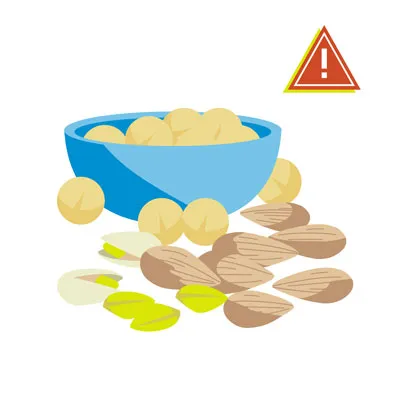 Assortment of nuts including macadamia, almonds, and pistachios, posing a danger or choking hazard for dogs
Assortment of nuts including macadamia, almonds, and pistachios, posing a danger or choking hazard for dogs
10. Milk and Dairy Products
The safety of milk and other dairy products for dogs is highly individualized. While some dogs can consume small amounts without issues, many are lactose intolerant or have allergies, leading to digestive problems such as diarrhea, gas, and stomach upset. Due to their high sugar and fat content, products like ice cream are particularly bad for dogs and should be avoided. Instead, consider freezing small pieces of dog-safe fruits for a cool treat. Cheese, in very small quantities, can be acceptable for some dogs, but it’s best to choose lower-fat varieties as an occasional treat to prevent pancreatitis risks.
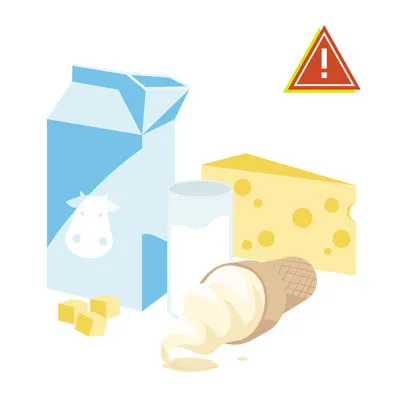 Glass of milk with a block of cheese, discussing dairy products and lactose intolerance in dogs
Glass of milk with a block of cheese, discussing dairy products and lactose intolerance in dogs
11. Mushrooms
It’s always safest to avoid feeding your dog mushrooms. While some commercial, washed white mushrooms from grocery stores might be technically non-toxic, many wild varieties contain a diverse array of toxins. These can lead to severe health issues, including kidney and liver failure, vomiting, diarrhea, hallucinations, and damage to red blood cells. Given the difficulty in distinguishing safe from toxic mushrooms, it is prudent to choose alternative treats to ensure your dog’s safety.
 Various types of mushrooms, emphasizing caution with feeding mushrooms to dogs due to potential toxins
Various types of mushrooms, emphasizing caution with feeding mushrooms to dogs due to potential toxins
12. Nutmeg and Cinnamon
Nutmeg should never be fed to dogs. This spice contains a compound called myristicin, which can cause hallucinations, disorientation, rapid heartbeat, and severe vomiting. The effects are stronger in higher doses or when consumed by smaller dogs. If your dog ingests any amount of nutmeg, contact your veterinarian immediately for guidance. Cinnamon, while not directly toxic, can irritate your dog’s mouth and digestive tract. In larger quantities, it can also lead to a dangerous drop in blood sugar, potentially causing serious health complications for your pup.
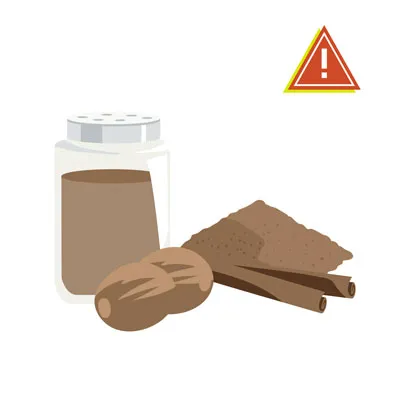 Ground nutmeg and cinnamon sticks, explaining the risks of these spices for dogs
Ground nutmeg and cinnamon sticks, explaining the risks of these spices for dogs
13. Onions, Garlic, Chives, and Leeks
Many pet owners are surprised to learn that herbs and vegetables from the allium family, including onions, garlic, chives, and leeks, are highly unsafe for their dogs. These plants contain sulfoxides and disulfides, compounds that can damage a dog’s red blood cells, leading to a condition called hemolytic anemia, which can be fatal. Onion and garlic powders are frequently found in many processed human foods, including some baby foods, so always meticulously read labels before sharing any store-bought items with your pet. Certain Japanese dog breeds, such as Akitas and Shiba Inus, are particularly sensitive to allium plants, but these are dangerous for all dogs.
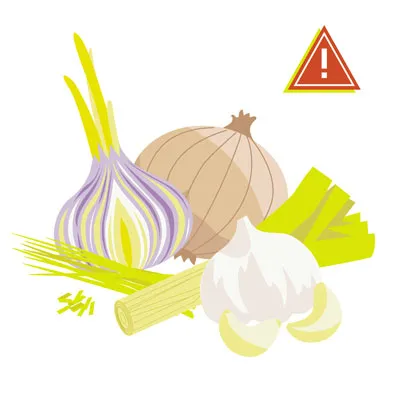 Assortment of allium vegetables: onions, garlic, chives, and leeks, highlighting their toxicity to dogs
Assortment of allium vegetables: onions, garlic, chives, and leeks, highlighting their toxicity to dogs
14. Salt
Excessive amounts of salt can disrupt the fluid balance in a dog’s cells, leading to severe health issues. Too much salt intake can cause tremors, seizures, vomiting, diarrhea, and even coma. Whether your dog is begging for a bite of rock salt, homemade play dough, or salty snacks like potato chips, it’s vital to resist those sad eyes to protect their health. Always ensure your dog has access to plenty of fresh water, especially if they’ve had any exposure to salt.
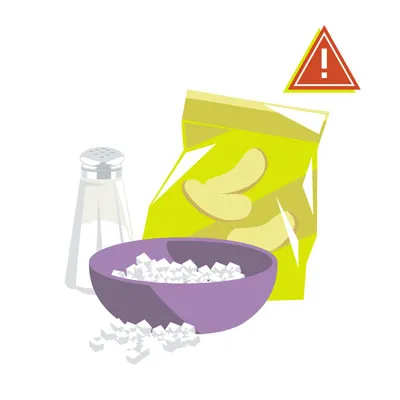 Pile of salt crystals, warning about excessive salt intake and its dangers for dogs
Pile of salt crystals, warning about excessive salt intake and its dangers for dogs
15. Spicy Food
Spicy foods are generally a bad idea for dogs. Ingredients like chili peppers can cause significant irritation to a dog’s mouth and digestive system. Ingesting hot, spicy food can lead to painful symptoms such as vomiting, stomach ulcers, and severe diarrhea. These issues can not only cause considerable discomfort for your dog but also lead to costly emergency veterinary visits. Stick to bland, dog-appropriate treats to avoid these unpleasant outcomes.
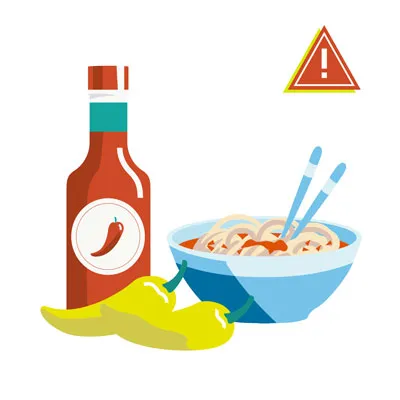 Red chili peppers, representing spicy food that can cause digestive upset in dogs
Red chili peppers, representing spicy food that can cause digestive upset in dogs
16. Sugar-Free Gum and Candy (Xylitol)
Xylitol is an artificial sweetener commonly found in many sugar-free human products, including gum, candies, mints, and baked goods. It is profoundly toxic to dogs. Ingestion of xylitol can cause a rapid and severe drop in blood sugar (hypoglycemia), leading to symptoms like weakness, loss of coordination, and even seizures. Some dogs may also experience acute liver failure, which can be fatal. Poisoning cases involving xylitol are on the rise, underscoring its danger; the amount of xylitol in just five pieces of gum has the potential to kill a 65-pound dog. Always check ingredient labels for xylitol, often listed as “birch sugar,” before giving your dog any human food item.
 Sugar-free chewing gum and candies, emphasizing the severe danger of xylitol for dogs
Sugar-free chewing gum and candies, emphasizing the severe danger of xylitol for dogs
17. Tomatoes and Raw Potatoes
Tomatoes and potatoes fall into a category of foods that are safe in some forms but unsafe in others. A ripened red tomato is generally considered okay for dogs in moderation. However, the green parts of the tomato plant, including the leaves, stems, and unripe green tomatoes, contain solanine, a glycoalkaloid toxin that can be harmful to dogs. Similarly, baked or boiled potatoes without any additives are generally safe in small amounts. Conversely, raw potatoes also contain solanine, making them toxic to dogs. Always ensure any potatoes offered are cooked and served plain, and keep green tomatoes and potato plants out of reach.
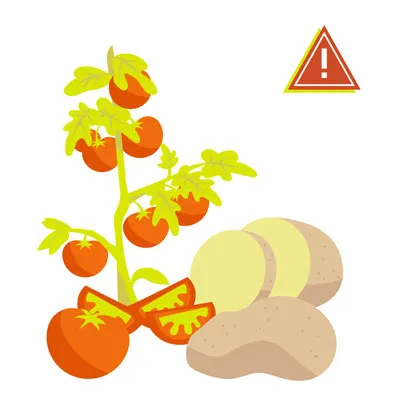 Green tomatoes and raw potatoes, illustrating the solanine content that makes them toxic to dogs
Green tomatoes and raw potatoes, illustrating the solanine content that makes them toxic to dogs
18. Tobacco
Tobacco and nicotine-containing products are highly dangerous and unhealthy for your dog. Exposure to nicotine can cause a range of severe symptoms, including vomiting, diarrhea, rapid or labored breathing, agitation, abnormal heart rate, wobbliness, muscle weakness, fluctuations in blood pressure, seizures, and tremors. More significant or frequent exposure can lead to blue gums and coma, ultimately proving fatal. Dogs, being curious creatures, might ingest a discarded cigarette or rummage through an ashtray. If your dog gets into tobacco, immediate veterinary attention is critical.
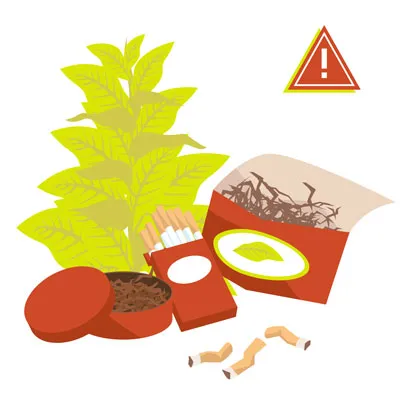 Cigarettes and tobacco products, warning against nicotine exposure for dogs and related health issues
Cigarettes and tobacco products, warning against nicotine exposure for dogs and related health issues
19. Yeast and Raw Dough
Yeast and raw dough are extremely unsafe for dogs due to multiple dangers. Firstly, raw dough can expand significantly in a dog’s warm stomach, leading to severe pain, bloating, and potentially life-threatening conditions like gastric dilatation-volvulus (GDV), or stomach torsion, which can rupture the stomach. Secondly, the yeast and sugar in raw dough ferment, producing ethanol (alcohol). This fermentation can cause alcohol toxicity in dogs, which can be rapidly fatal and requires immediate medical intervention. Always keep raw dough completely inaccessible to your pet.
 Bowl of raw dough and dry yeast, explaining the dangers of dough expansion and alcohol toxicity for dogs
Bowl of raw dough and dry yeast, explaining the dangers of dough expansion and alcohol toxicity for dogs
20. Raw Meat
Never feed your dog raw or undercooked meat. While some advocates promote raw diets, the risks associated with raw meat, such as contamination with harmful bacteria like Salmonella or E. coli, are significant for both dogs and humans. These pathogens can cause severe gastrointestinal illness in your dog and can also pose a public health risk. Additionally, bones in raw meat can present a choking hazard or cause internal injuries if ingested. Always ensure any meat given to your dog is thoroughly cooked and boneless.
 Various cuts of raw meat, advising against feeding raw or undercooked meat to dogs due to bacteria and choking hazards
Various cuts of raw meat, advising against feeding raw or undercooked meat to dogs due to bacteria and choking hazards
21. Rhubarb
Rhubarb, a plant commonly used in desserts, is not safe for pets. Its leaves contain soluble calcium oxalate crystals. If consumed in sufficiently large quantities, these crystals can bind with calcium in the body, causing a dangerous drop in calcium levels (hypocalcemia) and potentially leading to acute renal failure. Symptoms of rhubarb poisoning can include tremors, weakness, excessive drooling, bloody urine, changes in thirst and urination patterns, and vomiting.
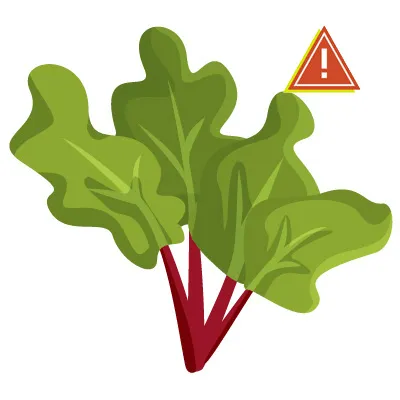 Fresh rhubarb stalks, illustrating the plant's toxicity to dogs due to soluble calcium oxalate crystals
Fresh rhubarb stalks, illustrating the plant's toxicity to dogs due to soluble calcium oxalate crystals
22. Star Fruit
Similar to rhubarb, star fruit also contains soluble calcium oxalate crystals, making it toxic to dogs. Ingesting this fruit can lead to the same dangerous drop in calcium levels and risk of renal failure. It’s best to ensure your dog does not snack on star fruit, opting for safer alternatives instead.
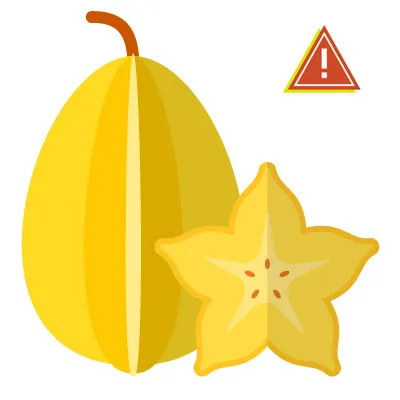 Sliced star fruit, indicating its toxicity for dogs due to calcium oxalate crystals
Sliced star fruit, indicating its toxicity for dogs due to calcium oxalate crystals
23. Flavored Water and Seltzer Water
When it comes to hydrating your dog, always err on the side of caution and provide fresh, clean plain water. Flavored and carbonated waters, including seltzer, often contain added ingredients that can be dangerous for pups, such as sugars, artificial sweeteners (like xylitol), or excessive salt. While plain seltzer water might be acceptable in very small, urgent amounts, it can still lead to gas and bloating. For optimal health and safety, plain tap water is always the best choice for your dog.
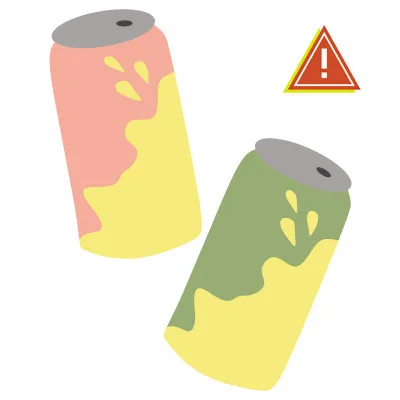 Glass of seltzer water with bubbles, cautioning against giving flavored or carbonated water to dogs
Glass of seltzer water with bubbles, cautioning against giving flavored or carbonated water to dogs
Foods Safe for Dogs
While the list of foods what a dog can’t eat can seem daunting, there are also many human foods that are perfectly safe and even healthy for your dog to enjoy in moderation. Some of the most popular and safest options include lean, dehydrated meats in very small amounts, apples (without the core), green beans, and carrots.
Here are some popular and healthy human foods that you can safely share with your dog. Remember, this list is not exhaustive, and new treats should always be introduced slowly to monitor for any adverse reactions. If you’re looking for more general dietary advice, especially what is good human food to feed dogs, our detailed guides can offer further insights.
1. Apples, Oranges, and Bananas
Apples (without cores or seeds) are a fantastic crunchy treat. Be sure to remove the core and seeds, as apple seeds contain cyanide. Small, cut pieces of the fleshy apple are perfectly fine. Oranges are safe in small amounts, providing a vitamin C boost. Bananas, given in moderation and peeled, are also a tasty and nutritious treat for your pup, packed with potassium and vitamins.
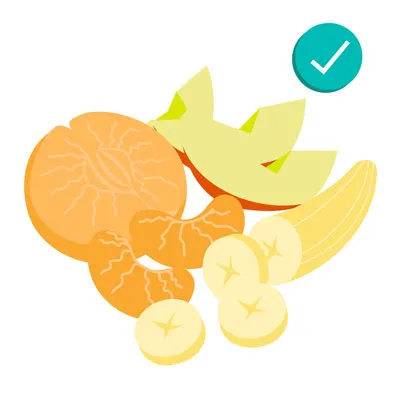 A bowl of various fruits: apples, oranges, and bananas, indicating safe human treats for dogs in moderation
A bowl of various fruits: apples, oranges, and bananas, indicating safe human treats for dogs in moderation
2. Blueberries and Blackberries
These small berries are not only delicious but also packed with antioxidants, fiber, phytochemicals, and vitamin C, making them excellent healthy treats for your dog. Most dogs love the taste of blueberries and blackberries, making them an easy and beneficial snack.
 Fresh blueberries and blackberries, healthy and safe berry treats for dogs rich in antioxidants
Fresh blueberries and blackberries, healthy and safe berry treats for dogs rich in antioxidants
3. Cantaloupe, Mango, Peaches, Pears, Pineapples, and Watermelon
Many fruits offer a delightful and safe snack for your dog. Cantaloupe is an excellent choice, as are mangoes, peaches, pears, and pineapples (all in moderation, with seeds, pits, and cores removed). Watermelon is especially refreshing on a warm day, but ensure you remove all rinds and seeds (even pale ones from seedless varieties) to prevent choking hazards and digestive upset. Experiment to see which tropical treats your dog enjoys most!
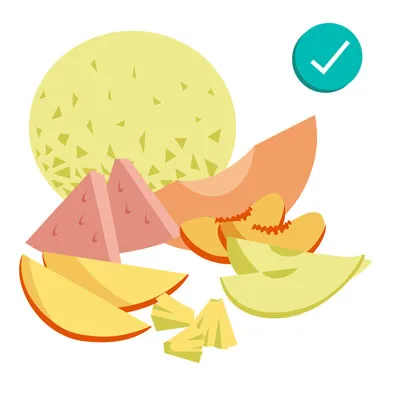 Assortment of dog-safe fruits: cantaloupe, mango, peaches, pears, pineapples, and watermelon slices
Assortment of dog-safe fruits: cantaloupe, mango, peaches, pears, pineapples, and watermelon slices
4. Carrots, Cucumber, and Celery
When searching for healthy, low-calorie options, remember the “three C’s” for your dog: carrots, cucumbers, and celery. These vegetables are particularly good for overweight dogs. Bite-sized carrot pieces provide a satisfying crunch and are rich in vitamins. Celery bites also offer a fun texture and can even help with bad breath. Cucumber slices are hydrating and contain numerous vitamins and minerals with very few carbohydrates or fats.
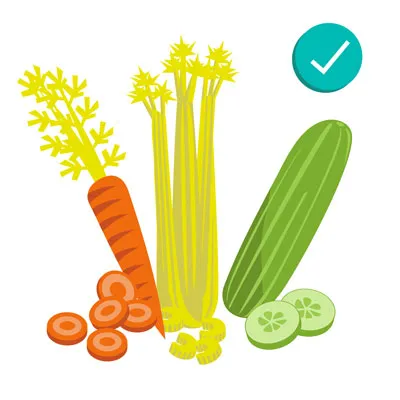 Fresh carrots, cucumber slices, and celery sticks, healthy low-calorie vegetables for dogs
Fresh carrots, cucumber slices, and celery sticks, healthy low-calorie vegetables for dogs
5. Cheese
While large quantities of dairy should generally be limited due to potential lactose intolerance, a small amount of cheese can be an acceptable treat for dogs who don’t exhibit sensitivity. Opt for lower-fat varieties like mozzarella as an occasional snack to minimize the risk of digestive upset or pancreatitis. Always observe your dog for any signs of discomfort after offering cheese.
 Blocks and slices of cheese, discussing safe dairy for dogs in moderation and low-fat options
Blocks and slices of cheese, discussing safe dairy for dogs in moderation and low-fat options
6. Eggs
Fully cooked eggs are a fantastic, protein-rich treat for your dog. Scrambled eggs, in particular, can be a great option for soothing an upset stomach while providing a highly digestible source of protein and essential nutrients. Ensure they are cooked thoroughly and served plain without any seasonings or butter. If your dog has an upset stomach, what food is good for dogs upset stomach like plain cooked eggs can be very helpful.
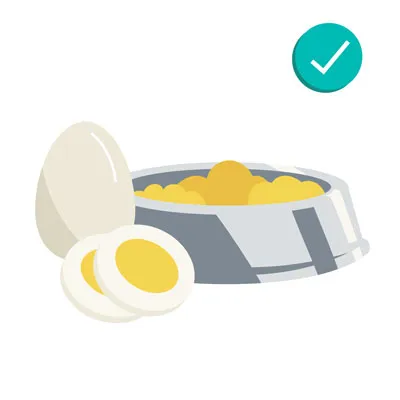 Cooked scrambled eggs, a protein-rich and safe food for dogs to soothe an upset stomach
Cooked scrambled eggs, a protein-rich and safe food for dogs to soothe an upset stomach
7. Peanuts, Peanut Butter, and Cashews
Peanuts and cashews are generally safe for dogs when given in small, unsalted, unflavored quantities. However, due to their high fat content, they should only be an occasional treat. For peanut butter, choose unsalted, natural varieties and strictly avoid any sugar-free options containing xylitol, which is highly toxic. Peanut butter can be a delicious, high-protein treat or a great way to administer medication.
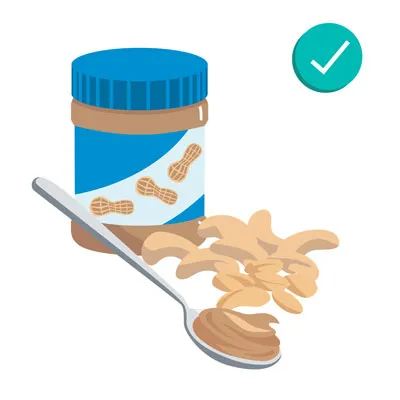 Bowl of peanuts, peanut butter, and cashews, safe and healthy nut treats for dogs in moderation
Bowl of peanuts, peanut butter, and cashews, safe and healthy nut treats for dogs in moderation
8. Popcorn and Corn
Air-popped popcorn, served unsalted and unbuttered, can be a fun snack for your dog. Just be sure to carefully remove any unpopped kernels to prevent choking. Similarly, plain corn (removed from the cob) is also acceptable when prepared without butter, salt, or spices. These make for simple, enjoyable treats.
 Air-popped popcorn and corn kernels, safe and unsalted snack options for dogs
Air-popped popcorn and corn kernels, safe and unsalted snack options for dogs
9. Coconut and Honey
In small amounts, coconut (including coconut milk and coconut oil) is generally fine for dogs. It contains lauric acid, which may offer benefits for skin and coat health and even allergies. However, some dogs might experience an upset stomach from fresh coconut or coconut milk, so introduce it cautiously. Always avoid coconut water, which is not safe, and prevent your dog from chewing on the fibrous shell, which can be a choking hazard. Honey, in moderation, is also safe and provides vitamins, minerals, and antioxidants.
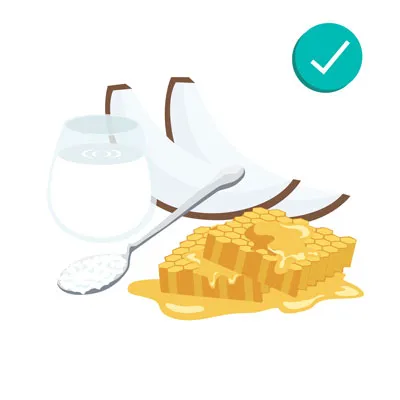 Fresh coconut and a jar of honey, safe human foods for dogs with health benefits in small amounts`
Fresh coconut and a jar of honey, safe human foods for dogs with health benefits in small amounts`
10. Shrimp and Fish
Plain, fully cooked shrimp is an excellent, low-fat protein source for dogs. Always remove the shell, head, tail, and legs, and ensure it’s unseasoned, unsalted, and unbuttered. Fish, especially salmon and sardines, can also be a healthy addition to your dog’s diet. Make sure it’s fully cooked, plain, and completely boneless. A general guideline is to offer fish no more than twice a week. Plain, canned tuna (packed in water, not oil) is safe in moderation to avoid excessive mercury and salt.
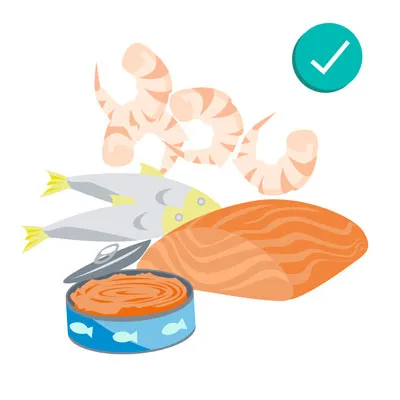 Cooked shrimp and fish fillet, safe and protein-rich seafood options for dogs
Cooked shrimp and fish fillet, safe and protein-rich seafood options for dogs
11. Turkey
Cooked turkey meat, when prepared correctly, is a healthy and safe source of lean protein for dogs. It’s crucial to remove all skin, excess fat, and especially bones before offering it. Give small, plain bites as a delicious treat, ensuring it’s unseasoned and unsalted. If you’re looking for guidance on what to give a labrador puppy to eat for a growing puppy, lean protein sources like cooked turkey can be beneficial.
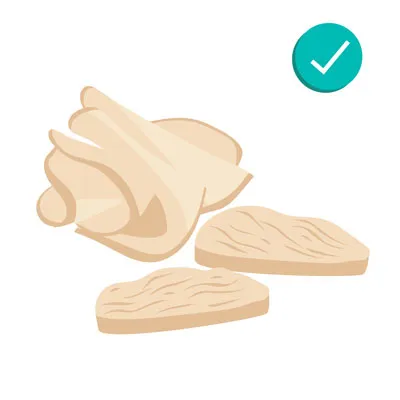 Cooked turkey meat, a lean protein source that is safe for dogs when unseasoned and boneless
Cooked turkey meat, a lean protein source that is safe for dogs when unseasoned and boneless
12. Grains, Wheat, and Quinoa
Grains, wheat, and quinoa can be fine for dogs in moderate amounts, provided your dog does not have an allergy. Like corn, a little bit of wheat or other grains is generally harmless. Quinoa is often considered a healthier filler option than many others due to its nutritional profile. Always monitor your dog for any signs of allergic reactions when introducing new grains. If you’re interested in feeding your dog to help them grow bigger, exploring protein-rich grains and other appropriate foods might be helpful, for example, understanding what can i feed my dog to make him bigger.
 Various grains including wheat and quinoa, safe and healthy additions to a dog's diet in moderation
Various grains including wheat and quinoa, safe and healthy additions to a dog's diet in moderation
13. Green Beans
Green beans are a popular and excellent choice for dogs, whether served raw, steamed, or from a can. They are safe, tasty, healthy, and low in calories, making them a great combination for a treat or a dietary supplement, especially for dogs needing to manage their weight. Always look for plain green beans without added spices, oils, or salt, and cut them into small, bite-sized pieces to prevent choking.
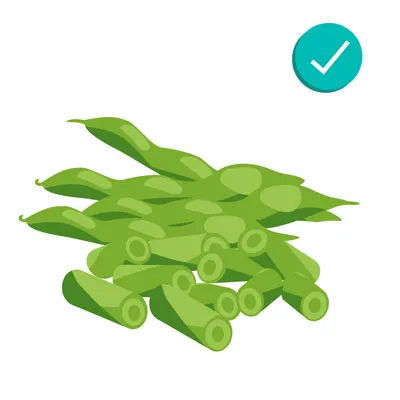 Fresh green beans, a healthy and safe vegetable snack for dogs
Fresh green beans, a healthy and safe vegetable snack for dogs
What Dogs Are Most at Risk if They Consume Toxic Foods?
While vigilance is essential for all dog owners, some dogs face a higher risk if they consume toxic foods. Understanding these risk factors can help you implement even stricter precautions.
- Small breeds vs. large breeds: Smaller dogs are generally more vulnerable to toxins due to their lower body weight. A dose of a toxic substance that might cause mild symptoms in a large dog could be severely harmful or even fatal to a small breed.
- Puppies: Younger dogs have less developed digestive and immune systems. Their curious nature also makes them more prone to ingesting inappropriate items. This immaturity puts them at greater risk from certain substances.
- Elderly dogs: Older dogs may have higher risks due to age-related health conditions, such as decreased organ function or weakened immune systems. Their bodies may not process or eliminate toxins as efficiently as younger, healthier dogs.
- Dogs with pre-existing conditions: Any dog with underlying health issues, such as diabetes, kidney disease, liver problems, or sensitive gastrointestinal tracts, will be at greater risk if they consume toxic foods. These conditions can worsen the impact of a toxin or complicate treatment.
How To Prevent Dogs from Eating Toxic Foods
Accidents can happen, but proactive steps are vital to minimizing the risk of your beloved pup encountering unsafe human foods.
1. Store foods out of reach
The simplest and most effective prevention method is to ensure that all potentially toxic foods are stored securely out of your dog’s reach. This means keeping dangerous items on high shelves, in sealed containers, or locked away in cabinets that your ingenious pup cannot access.
2. Avoid feeding dogs from your plate
Resist the urge to feed your dog scraps from your plate or during meal preparation in the kitchen, even if it’s just a “tiny” treat. This practice can encourage begging and teach your dog that human food is fair game, increasing the likelihood of them sneaking something dangerous when you’re not looking. It’s safest to only provide treats specifically formulated for dogs.
3. Educate family members and guests
Ensure everyone in your household, including children and guests, understands the rules about feeding your dog. Explain that no matter how tempting it may be to share, they should never sneak food to your dog, as even seemingly harmless tidbits could be toxic or lead to bad habits.
4. Be careful during holidays
Holidays often involve large gatherings, abundant food, and a more relaxed atmosphere, which can inadvertently create opportunities for your dog to access harmful items. Be extra cautious during these busy periods. Keep food off low tables, immediately clear plates, and inform all guests about your dog’s dietary restrictions. Have emergency contact information readily available for 24/7 veterinary services or pet poison control.
What To Do if Your Dog Eats Something Toxic
If, despite your best efforts, your dog consumes a toxic food, acting quickly and knowledgeably can make a critical difference in their outcome.
First, familiarize yourself with the common symptoms of food toxicity. These can vary widely depending on the substance ingested but often include lethargy, distress, pain, vomiting, diarrhea (sometimes bloody), excessive drooling, tremors, seizures, or an abnormally bloated and hard stomach, which can indicate a life-threatening condition like GDV.
If you observe any concerning symptoms or suspect your dog has eaten something toxic, follow these crucial steps:
- Call your veterinarian or pet poison control immediately. Time is critical in poisoning cases. Early intervention typically leads to more successful treatments and shorter hospitalization periods. Do not wait for symptoms to worsen.
- Be prepared with all relevant information. When you call, provide details such as the type of food ingested, an estimated amount consumed, and the time of ingestion. If possible, have the packaging of the food or product ready.
- Avoid home remedies unless advised by your veterinarian. Do not attempt to induce vomiting or administer any home remedies without specific instructions from a veterinary professional. Depending on the toxin, inducing vomiting can sometimes cause more harm (e.g., if the substance is corrosive or if your dog is already showing neurological symptoms). Your vet will advise the safest course of action based on the specific circumstances.
Keeping Your Dog Healthy and Safe with Dog Care Story
Navigating the world of human foods and understanding what food is bad for a dog to eat can feel overwhelming. From common household items to specific ingredients, pets are often drawn to things that can harm them. By using this comprehensive guide and maintaining vigilance, you can significantly reduce the risks and help keep your cherished canine companion safe from dangerous foods.
Fortunately, there’s a vast array of foods that are safe and healthy for your dog to enjoy. Explore our list of safe treats and discover new favorites for your good boy or girl. If you ever find yourself unsure about a specific food, always prioritize your dog’s health and consult with your veterinarian for expert advice. Your proactive care and informed decisions are the best defense against food-related health issues, ensuring your dog lives a long, happy, and healthy life by your side.
References
- “Top 10 dog poisons,” Hilary Parker (5/2023), WebMD, https://www.webmd.com/pets/dogs/top-10-dog-poisons
- “What happens if a dog eats chocolate?” (10/2023), Colorado State University, https://vetmedbiosci.colostate.edu/vth/animal-health/why-is-chocolate-bad-for-dogs/
- “Fruits and vegetables dogs can or can’t eat,” (3/2024), American Kennel Club, https://www.akc.org/expert-advice/nutrition/fruits-vegetables-dogs-can-and-cant-eat/
- “What to do if your dog drinks alcohol,” Jerry Klein (7/2023), American Kennel Club, https://www.akc.org/expert-advice/vets-corner/is-alcohol-dangerous-for-dogs/
- “Can dogs eat apples?” Hector Joy (12/2022), PetMD, https://www.petmd.com/dog/general-health/can-dogs-eat-apples
- “Can dogs eat plums?” Katie Koschalk (7/2023), Chewy, https://be.chewy.com/nutrition-pet-diet-tips-can-dogs-eat-plums/
- “Avocado (Persea spp) Toxicosis in Animals,” Cristine Hayes (9/2024), Merck Veterinary Manual, https://www.merckvetmanual.com/toxicology/food-hazards/avocado-persea-spp-toxicosis-in-animals
- “People foods to avoid feeding your pets,” (n.d.), ASPCA, https://www.aspca.org/pet-care/animal-poison-control/people-foods-avoid-feeding-your-pets
- “People foods dogs can and can’t eat,” (3/2024), American Kennel Club, https://www.akc.org/expert-advice/nutrition/human-foods-dogs-can-and-cant-eat/
- “Can dogs eat nuts?” Amanda Ardente (1/2023), PetMD, https://www.petmd.com/dog/nutrition/can-dogs-eat-nuts
- “Can dogs drink milk?” Sandra C. Mitchell (1/2024), PetMD, https://www.petmd.com/dog/nutrition/can-dogs-drink-milk
- “Can dogs have nutmeg?” Barri J. Morrison (11/2023), PetMD, https://www.petmd.com/nutmeg-safe-dogs
- “Onion, garlic, chive, and leek poisoning in dogs,” Renee Schmid et al. (2024), VCA Animal Hospitals, https://vcahospitals.com/know-your-pet/onion-garlic-chive-and-leek-toxicity-in-dogs
- “Can dogs eat tomatoes?” Anna Burke (10/2024), American Kennel Club, https://www.akc.org/expert-advice/nutrition/can-dogs-eat-tomatoes/
- “Can dogs eat potatoes?” Katherine Ripley (11/2023), American Kennel Club, https://www.akc.org/expert-advice/nutrition/can-dogs-eat-potatoes/
- “What to do if your dog eats a cigarette butt,” (6/2023), American Kennel Club, https://www.akc.org/expert-advice/health/dog-ate-cigarette-butt/
- “Dough & dogs: Why it’s bad and what you can do,” Lisa Goldstein (7/2024), Preventive Vet, https://www.preventivevet.com/dogs/dough-is-toxic-to-dogs
- “Rhubarb,” (n.d.), Pet Poison Helpline, https://www.petpoisonhelpline.com/poison/rhubarb/
- “Can dogs drink carbonated water?” Heather Logue (n.d.), Rover, https://www.rover.com/blog/can-dogs-drink-carbonated-water/
- “What fruits can dogs eat?” Ellen Malmanger (2/2024), PetMD, https://www.petmd.com/dog/nutrition/what-fruits-can-dogs-eat
- “Can dogs have green beans?” Anna Burke (8/2022), American Kennel Club, https://www.akc.org/expert-advice/nutrition/can-dogs-have-green-beans/
- “About pet food safety,” (4/2024), CDC, https://www.cdc.gov/healthy-pets/about/pet-food-safety.html
